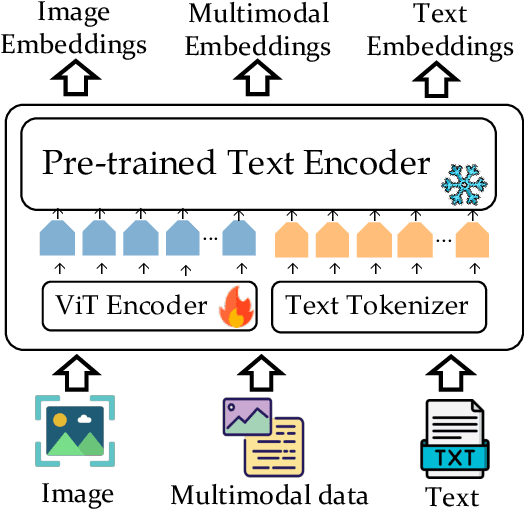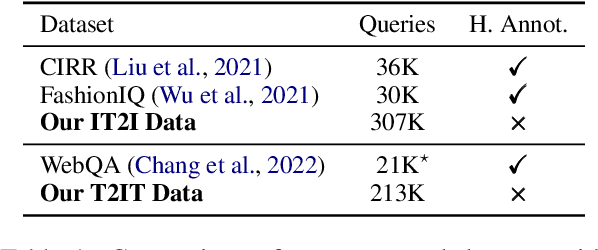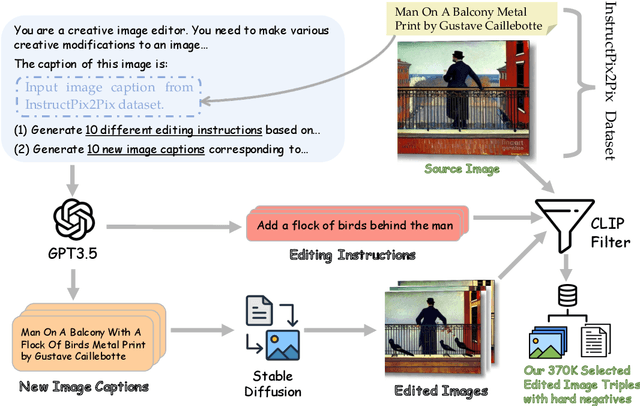Bo Zhao
MLVU: A Comprehensive Benchmark for Multi-Task Long Video Understanding
Jun 06, 2024



Abstract:The evaluation of Long Video Understanding (LVU) performance poses an important but challenging research problem. Despite previous efforts, the existing video understanding benchmarks are severely constrained by several issues, especially the insufficient lengths of videos, a lack of diversity in video types and evaluation tasks, and the inappropriateness for evaluating LVU performances. To address the above problems, we propose a new benchmark, called MLVU (Multi-task Long Video Understanding Benchmark), for the comprehensive and in-depth evaluation of LVU. MLVU presents the following critical values: 1) The substantial and flexible extension of video lengths, which enables the benchmark to evaluate LVU performance across a wide range of durations. 2) The inclusion of various video genres, e.g., movies, surveillance footage, egocentric videos, cartoons, game videos, etc., which reflects the models' LVU performances in different scenarios. 3) The development of diversified evaluation tasks, which enables a comprehensive examination of MLLMs' key abilities in long-video understanding. The empirical study with 20 latest MLLMs reveals significant room for improvement in today's technique, as all existing methods struggle with most of the evaluation tasks and exhibit severe performance degradation when handling longer videos. Additionally, it suggests that factors such as context length, image-understanding quality, and the choice of LLM backbone can play critical roles in future advancements. We anticipate that MLVU will advance the research of long video understanding by providing a comprehensive and in-depth analysis of MLLMs.
VISTA: Visualized Text Embedding For Universal Multi-Modal Retrieval
Jun 06, 2024



Abstract:Multi-modal retrieval becomes increasingly popular in practice. However, the existing retrievers are mostly text-oriented, which lack the capability to process visual information. Despite the presence of vision-language models like CLIP, the current methods are severely limited in representing the text-only and image-only data. In this work, we present a new embedding model VISTA for universal multi-modal retrieval. Our work brings forth threefold technical contributions. Firstly, we introduce a flexible architecture which extends a powerful text encoder with the image understanding capability by introducing visual token embeddings. Secondly, we develop two data generation strategies, which bring high-quality composed image-text to facilitate the training of the embedding model. Thirdly, we introduce a multi-stage training algorithm, which first aligns the visual token embedding with the text encoder using massive weakly labeled data, and then develops multi-modal representation capability using the generated composed image-text data. In our experiments, VISTA achieves superior performances across a variety of multi-modal retrieval tasks in both zero-shot and supervised settings. Our model, data, and source code are available at https://github.com/FlagOpen/FlagEmbedding.
Omni6DPose: A Benchmark and Model for Universal 6D Object Pose Estimation and Tracking
Jun 06, 2024Abstract:6D Object Pose Estimation is a crucial yet challenging task in computer vision, suffering from a significant lack of large-scale datasets. This scarcity impedes comprehensive evaluation of model performance, limiting research advancements. Furthermore, the restricted number of available instances or categories curtails its applications. To address these issues, this paper introduces Omni6DPose, a substantial dataset characterized by its diversity in object categories, large scale, and variety in object materials. Omni6DPose is divided into three main components: ROPE (Real 6D Object Pose Estimation Dataset), which includes 332K images annotated with over 1.5M annotations across 581 instances in 149 categories; SOPE(Simulated 6D Object Pose Estimation Dataset), consisting of 475K images created in a mixed reality setting with depth simulation, annotated with over 5M annotations across 4162 instances in the same 149 categories; and the manually aligned real scanned objects used in both ROPE and SOPE. Omni6DPose is inherently challenging due to the substantial variations and ambiguities. To address this challenge, we introduce GenPose++, an enhanced version of the SOTA category-level pose estimation framework, incorporating two pivotal improvements: Semantic-aware feature extraction and Clustering-based aggregation. Moreover, we provide a comprehensive benchmarking analysis to evaluate the performance of previous methods on this large-scale dataset in the realms of 6D object pose estimation and pose tracking.
The SkatingVerse Workshop & Challenge: Methods and Results
May 27, 2024

Abstract:The SkatingVerse Workshop & Challenge aims to encourage research in developing novel and accurate methods for human action understanding. The SkatingVerse dataset used for the SkatingVerse Challenge has been publicly released. There are two subsets in the dataset, i.e., the training subset and testing subset. The training subsets consists of 19,993 RGB video sequences, and the testing subsets consists of 8,586 RGB video sequences. Around 10 participating teams from the globe competed in the SkatingVerse Challenge. In this paper, we provide a brief summary of the SkatingVerse Workshop & Challenge including brief introductions to the top three methods. The submission leaderboard will be reopened for researchers that are interested in the human action understanding challenge. The benchmark dataset and other information can be found at: https://skatingverse.github.io/.
VTG-LLM: Integrating Timestamp Knowledge into Video LLMs for Enhanced Video Temporal Grounding
May 22, 2024



Abstract:Video Temporal Grounding (VTG) focuses on accurately identifying event timestamps within a particular video based on a linguistic query, playing a vital role in downstream tasks such as video browsing and editing. While Video Large Language Models (video LLMs) have made significant progress in understanding video content, they often face challenges in accurately pinpointing timestamps within videos, which limits their performance on VTG tasks. Therefore, to improve video LLMs' ability to effectively locate timestamps, we argue that two critical aspects need to be enhanced. First, it is essential to have high-quality instructional tuning datasets that encompass mainstream VTG tasks. Second, directly incorporating timestamp knowledge into video LLMs is crucial, as it enables models to efficiently comprehend timestamp information. To address these needs, we first introduce VTG-IT-120K, a high-quality and comprehensive instruction tuning dataset that covers VTG tasks such as moment retrieval, dense video captioning, video summarization, and video highlight detection. Furthermore, we propose a specially designed video LLM model for VTG tasks, VTG-LLM, which (1) effectively integrates timestamp knowledge into visual tokens; (2) incorporates absolute-time tokens that specifically handle timestamp knowledge, thereby avoiding concept shifts; and (3) introduces a lightweight, high-performance slot-based token compression method to facilitate the sampling of more video frames. Comprehensive experiments showcase the superior performance of VTG-LLM in comparison to other video LLM methods across various VTG tasks. Our code and datasets are available at \url{https://github.com/gyxxyg/VTG-LLM}.
Efficient Multimodal Large Language Models: A Survey
May 17, 2024



Abstract:In the past year, Multimodal Large Language Models (MLLMs) have demonstrated remarkable performance in tasks such as visual question answering, visual understanding and reasoning. However, the extensive model size and high training and inference costs have hindered the widespread application of MLLMs in academia and industry. Thus, studying efficient and lightweight MLLMs has enormous potential, especially in edge computing scenarios. In this survey, we provide a comprehensive and systematic review of the current state of efficient MLLMs. Specifically, we summarize the timeline of representative efficient MLLMs, research state of efficient structures and strategies, and the applications. Finally, we discuss the limitations of current efficient MLLM research and promising future directions. Please refer to our GitHub repository for more details: https://github.com/lijiannuist/Efficient-Multimodal-LLMs-Survey.
Understanding the Difficulty of Solving Cauchy Problems with PINNs
May 04, 2024Abstract:Physics-Informed Neural Networks (PINNs) have gained popularity in scientific computing in recent years. However, they often fail to achieve the same level of accuracy as classical methods in solving differential equations. In this paper, we identify two sources of this issue in the case of Cauchy problems: the use of $L^2$ residuals as objective functions and the approximation gap of neural networks. We show that minimizing the sum of $L^2$ residual and initial condition error is not sufficient to guarantee the true solution, as this loss function does not capture the underlying dynamics. Additionally, neural networks are not capable of capturing singularities in the solutions due to the non-compactness of their image sets. This, in turn, influences the existence of global minima and the regularity of the network. We demonstrate that when the global minimum does not exist, machine precision becomes the predominant source of achievable error in practice. We also present numerical experiments in support of our theoretical claims.
Advances and Open Challenges in Federated Learning with Foundation Models
Apr 29, 2024



Abstract:The integration of Foundation Models (FMs) with Federated Learning (FL) presents a transformative paradigm in Artificial Intelligence (AI), offering enhanced capabilities while addressing concerns of privacy, data decentralization, and computational efficiency. This paper provides a comprehensive survey of the emerging field of Federated Foundation Models (FedFM), elucidating their synergistic relationship and exploring novel methodologies, challenges, and future directions that the FL research field needs to focus on in order to thrive in the age of foundation models. A systematic multi-tiered taxonomy is proposed, categorizing existing FedFM approaches for model training, aggregation, trustworthiness, and incentivization. Key challenges, including how to enable FL to deal with high complexity of computational demands, privacy considerations, contribution evaluation, and communication efficiency, are thoroughly discussed. Moreover, the paper explores the intricate challenges of communication, scalability and security inherent in training/fine-tuning FMs via FL, highlighting the potential of quantum computing to revolutionize the training, inference, optimization and data encryption processes. This survey underscores the importance of further research to propel innovation in FedFM, emphasizing the need for developing trustworthy solutions. It serves as a foundational guide for researchers and practitioners interested in contributing to this interdisciplinary and rapidly advancing field.
Tele-FLM Technical Report
Apr 25, 2024



Abstract:Large language models (LLMs) have showcased profound capabilities in language understanding and generation, facilitating a wide array of applications. However, there is a notable paucity of detailed, open-sourced methodologies on efficiently scaling LLMs beyond 50 billion parameters with minimum trial-and-error cost and computational resources. In this report, we introduce Tele-FLM (aka FLM-2), a 52B open-sourced multilingual large language model that features a stable, efficient pre-training paradigm and enhanced factual judgment capabilities. Tele-FLM demonstrates superior multilingual language modeling abilities, measured by BPB on textual corpus. Besides, in both English and Chinese foundation model evaluation, it is comparable to strong open-sourced models that involve larger pre-training FLOPs, such as Llama2-70B and DeepSeek-67B. In addition to the model weights, we share the core designs, engineering practices, and training details, which we expect to benefit both the academic and industrial communities.
M3D: Advancing 3D Medical Image Analysis with Multi-Modal Large Language Models
Mar 31, 2024



Abstract:Medical image analysis is essential to clinical diagnosis and treatment, which is increasingly supported by multi-modal large language models (MLLMs). However, previous research has primarily focused on 2D medical images, leaving 3D images under-explored, despite their richer spatial information. This paper aims to advance 3D medical image analysis with MLLMs. To this end, we present a large-scale 3D multi-modal medical dataset, M3D-Data, comprising 120K image-text pairs and 662K instruction-response pairs specifically tailored for various 3D medical tasks, such as image-text retrieval, report generation, visual question answering, positioning, and segmentation. Additionally, we propose M3D-LaMed, a versatile multi-modal large language model for 3D medical image analysis. Furthermore, we introduce a new 3D multi-modal medical benchmark, M3D-Bench, which facilitates automatic evaluation across eight tasks. Through comprehensive evaluation, our method proves to be a robust model for 3D medical image analysis, outperforming existing solutions. All code, data, and models are publicly available at: https://github.com/BAAI-DCAI/M3D.
 Add to Chrome
Add to Chrome Add to Firefox
Add to Firefox Add to Edge
Add to Edge